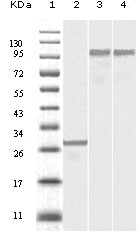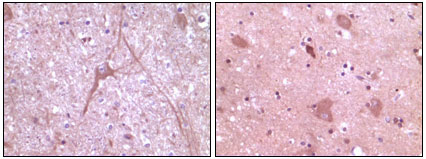Dynamin II Monoclonal Antibody
- Catalog No.:YM0203
- Applications:WB;IHC;IF;ELISA
- Reactivity:Human
- Target:
- Dynamin II
- Fields:
- >>Phospholipase D signaling pathway;>>Endocytosis;>>Fc gamma R-mediated phagocytosis;>>Synaptic vesicle cycle;>>Endocrine and other factor-regulated calcium reabsorption;>>Bacterial invasion of epithelial cells;>>Salmonella infection
- Gene Name:
- DNM2
- Protein Name:
- Dynamin-2
- Human Gene Id:
- 1785
- Human Swiss Prot No:
- P50570
- Mouse Swiss Prot No:
- P39054
- Immunogen:
- Purified recombinant fragment of Dynamin II expressed in E. Coli.
- Specificity:
- Dynamin II Monoclonal Antibody detects endogenous levels of Dynamin II protein.
- Formulation:
- Liquid in PBS containing 50% glycerol, 0.5% BSA and 0.02% sodium azide.
- Source:
- Monoclonal, Mouse
- Dilution:
- WB 1:500 - 1:2000. IHC 1:200 - 1:1000. ELISA: 1:10000.. IF 1:50-200
- Purification:
- Affinity purification
- Storage Stability:
- -15°C to -25°C/1 year(Do not lower than -25°C)
- Other Name:
- DNM2;DYN2;Dynamin-2
- Molecular Weight(Da):
- 98kD
- References:
- 1. Annie Quan and Phillip J. Robinson. Methods Enzymol. 2005; 404:556-69.
2. Jiyun Yoo, Moon-Jin Jeong, Byoung-Mog Kwon. J. Biol. Chem., Mar 2002; 277: 11904 – 11909.
- Background:
- dynamin 2(DNM2) Homo sapiens Dynamins represent one of the subfamilies of GTP-binding proteins. These proteins share considerable sequence similarity over the N-terminal portion of the molecule, which contains the GTPase domain. Dynamins are associated with microtubules. They have been implicated in cell processes such as endocytosis and cell motility, and in alterations of the membrane that accompany certain activities such as bone resorption by osteoclasts. Dynamins bind many proteins that bind actin and other cytoskeletal proteins. Dynamins can also self-assemble, a process that stimulates GTPase activity. Five alternatively spliced transcripts encoding different proteins have been described. Additional alternatively spliced transcripts may exist, but their full-length nature has not been determined. [provided by RefSeq, Jun 2010],
- Function:
- catalytic activity:GTP + H(2)O = GDP + phosphate.,disease:Defects in DNM2 are a cause of centronuclear myopathy autosomal dominant (ADCNM) [MIM:160150]; also known as autosomal dominant myotubular myopathy. Centronuclear myopathies (CNMs) are congenital muscle disorders characterized by progressive muscular weakness and wasting involving mainly limb girdle, trunk, and neck muscles. It may also affect distal muscles. Weakness may be present during childhood or adolescence or may not become evident until the third decade of life. Ptosis is a frequent clinical feature. CNMs comprise a wide spectrum of phenotypes, ranging from severe neonatal to mild late-onset familial forms. The most prominent histopathologic features include high frequency of centrally located nuclei in muscle fibers not secondary to regeneration, radial arrangement of sarcoplasmic strands around the central nuclei, and p
- Subcellular Location:
- Cytoplasm. Cytoplasm, cytoskeleton. Cell junction . Membrane, clathrin-coated pit . Cell junction, synapse, postsynaptic density. Cell junction, synapse. Midbody. Cell projection, phagocytic cup . Cytoplasmic vesicle, phagosome membrane ; Peripheral membrane protein . Colocalizes with CTTN at the basis of filopodia in hippocampus neuron growth zones (By similarity). Microtubule-associated. Also found in the postsynaptic density of neuronal cells. Co-localizes with PIK3C3 and RAB5A to the nascent phagosome (By similarity). .
- Expression:
- Ubiquitously expressed.
- June 19-2018
- WESTERN IMMUNOBLOTTING PROTOCOL
- June 19-2018
- IMMUNOHISTOCHEMISTRY-PARAFFIN PROTOCOL
- June 19-2018
- IMMUNOFLUORESCENCE PROTOCOL
- September 08-2020
- FLOW-CYTOMEYRT-PROTOCOL
- May 20-2022
- Cell-Based ELISA│解您多样本WB检测之困扰
- July 13-2018
- CELL-BASED-ELISA-PROTOCOL-FOR-ACETYL-PROTEIN
- July 13-2018
- CELL-BASED-ELISA-PROTOCOL-FOR-PHOSPHO-PROTEIN
- July 13-2018
- Antibody-FAQs
- Products Images

- Western Blot analysis using Dynamin II Monoclonal Antibody against truncated Dynamin-2 recombinant protein (1), SKN-SH cell lysate (2) and NIH/3T3 cell lysate (3).

- Immunohistochemistry analysis of paraffin-embedded human cerebrum tissue (left) and myelencephalon tissue (right), showing cytoplasmic localization with DAB staining using Dynamin II Monoclonal Antibody.



